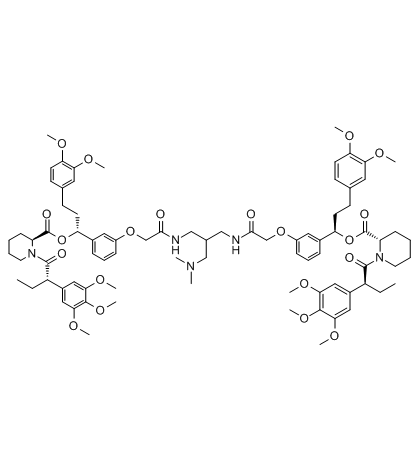| Description |
AP20187 is a cell-permeable ligand used to dimerize FK506-binding protein (FKBP) fusion proteins and initiate biological signaling cascades and gene expression or disrupt protein-protein interactions.
|
| Related Catalog |
|
| Target |
FKBP homodimerizer[1]
|
| In Vitro |
When LNCaP cells are treated with AP20187 (100 nM), ro-iCaspase-9 levels are significantly reduced, and the smaller processed active caspase-9 becomes apparent[2].
|
| In Vivo |
Real-time PCR analysis shows that AP20187 (0.5 mg/kg, 2 mg/kg, or 5 mg/kg) treatment significantly increases the levels of CHOP mRNA in the CNS of PLP/Fv2E-PERK mice at PID12. AP20187 treatment significantly alleviates EAE-induced myelin damage in these mice. AP20187 treatment significantly reduces the number of degenerating axons and increases the density of axons in the demyelinating lesions in the lumbar spinal cord of PLP/Fv2E-PERK mice[2].
|
| Cell Assay |
For the in vitro study, 16 h after ADV infection, cells are treated with R1881 (10 nM), AP20187 (10 nM), both, or neither for 8 h. Cells are then rinsed with PBS and fixed with 4% paraformaldehyde for 1 h at room temperature. After rinsing with PBS, cells are incubated in ice-cold permeabilization solution (0.1% Triton X-100, 0.1% sodium citrate) for 2 min at 0°C. Cells are rinsed with PBS and stained with TUNEL reaction mixture for 60 min at 37°C. After another PBS wash, cells are incubated with Converter-AP for 30 min at 37°C. Cells are rinsed and incubated with substrate 5-bromo-4-chloro-3-indolyl phosphate/nitroblue tetrazolium for 30 min. After a final PBS rinse (repeated twice), cells are microphotographed[2].
|
| Animal Admin |
Mice[2] To activate the transgene Fv2E-PERK in oligodendrocytes, PLP/Fv2E-PERK transgenic mice are given intraperitoneal injections of AP20187 daily at a dose of 0.5 mg/kg, 2 mg/kg, or 5 mg/kg. Lyophilized AP20187 is dissolved in 100% ethanol at a concentration of 62.5 mg/mL stock solution and stored at −20°C. Injection solutions consist of 4% ethanol, 10% PEG-400, and 2% Tween-20 in water. The transgenic mice receiving only the vehicle (4% ethanol, 10% PEG-400, 2% Tween-20 in water) served as controls.
|
| References |
[1]. Ahmed S, et al. Photocleavable dimerizer for the rapid reversal of molecular trap antagonists. J Biol Chem. 2014 Feb 21;289(8):4546-52. [2]. Lin W, et al. Oligodendrocyte-specific activation of PERK signaling protects mice against experimental autoimmune encephalomyelitis. J Neurosci. 2013 Apr 3;33(14):5980-91. [3]. Haas ME, et al. The Role of Proprotein Convertase Subtilisin/Kexin Type 9 in Nephrotic Syndrome-Associated Hypercholesterolemia. Circulation. 2016 Jul 5;134(1):61-72.
|
